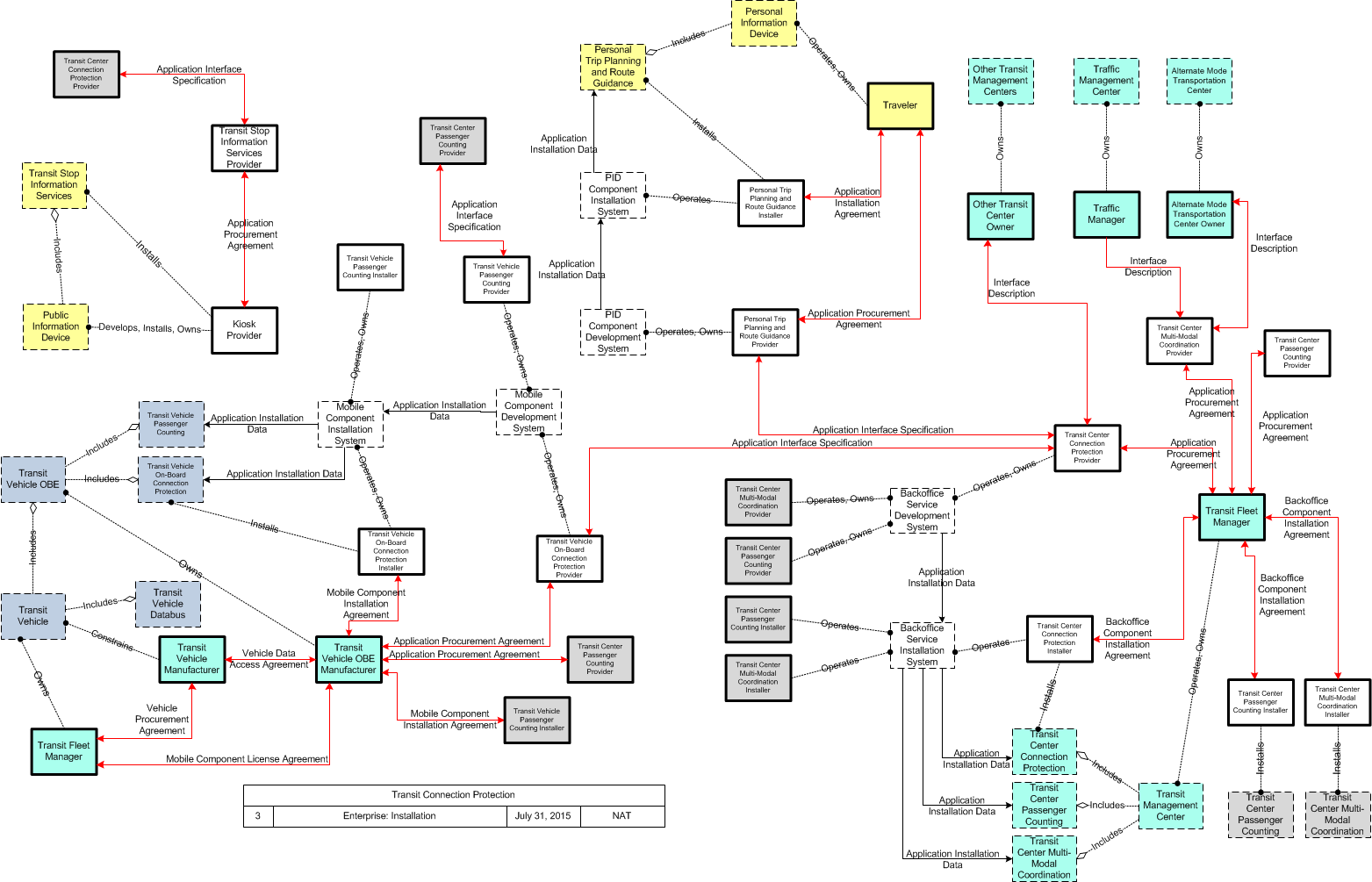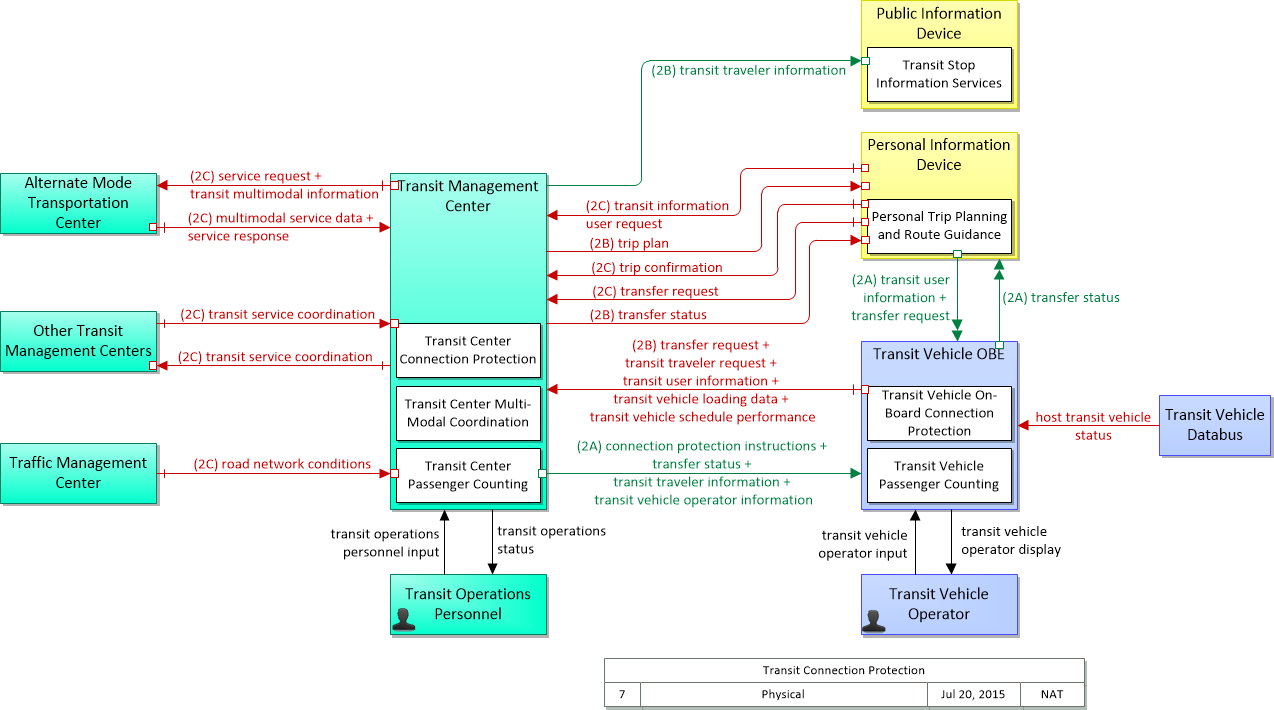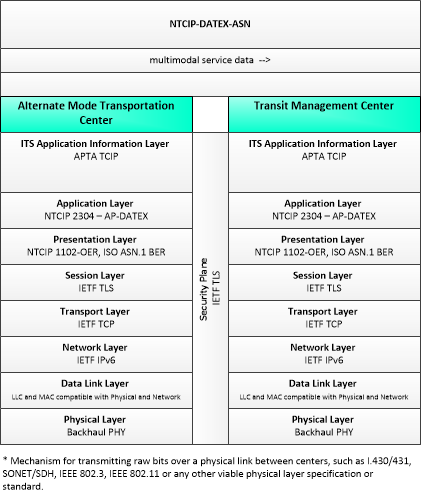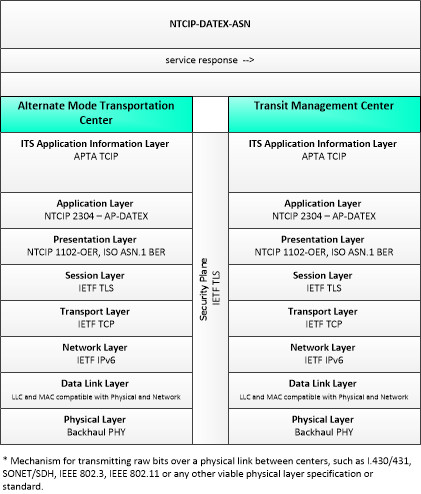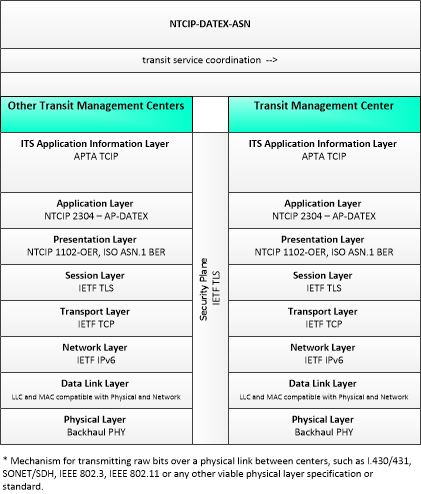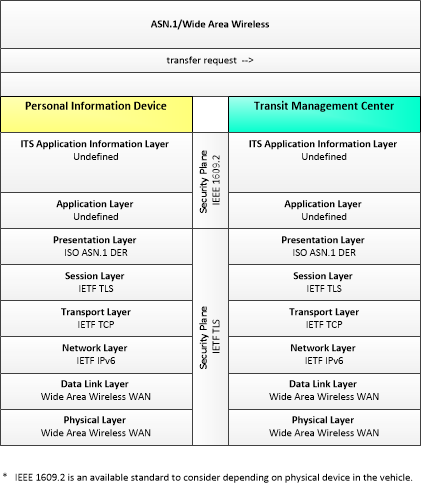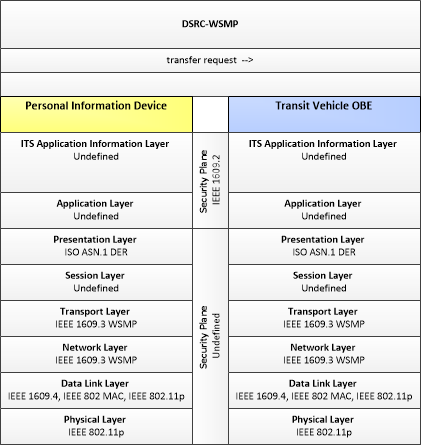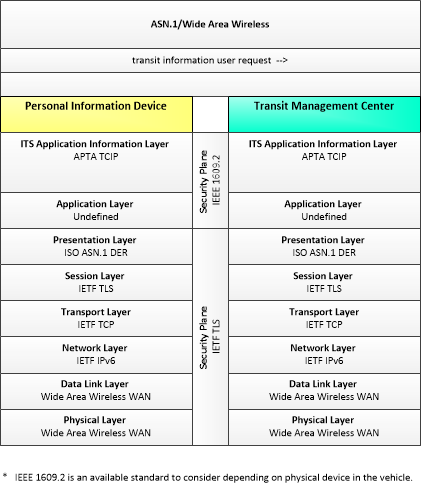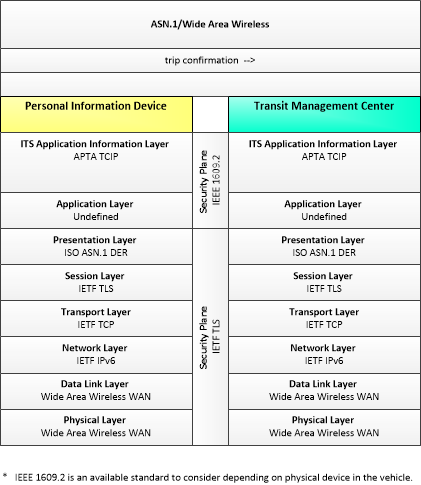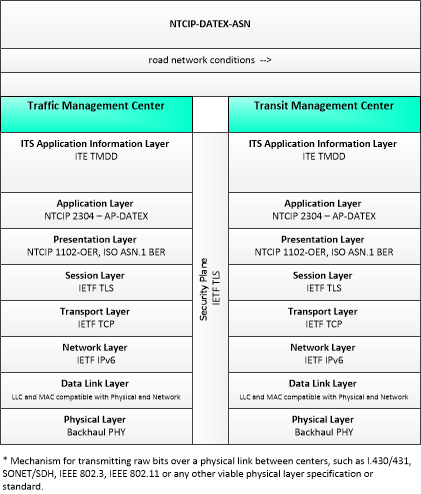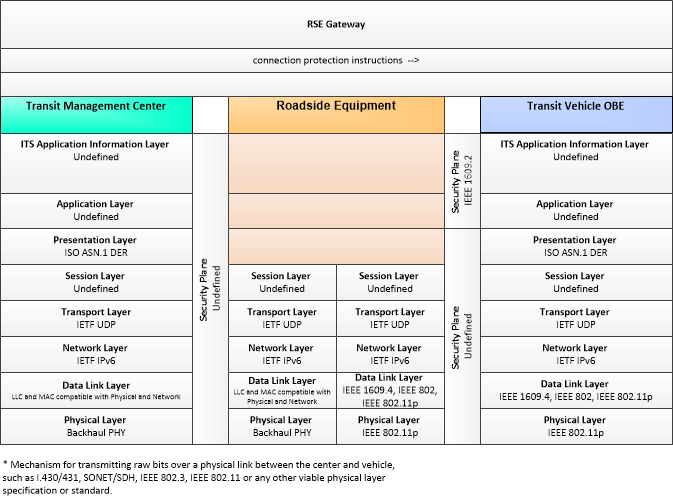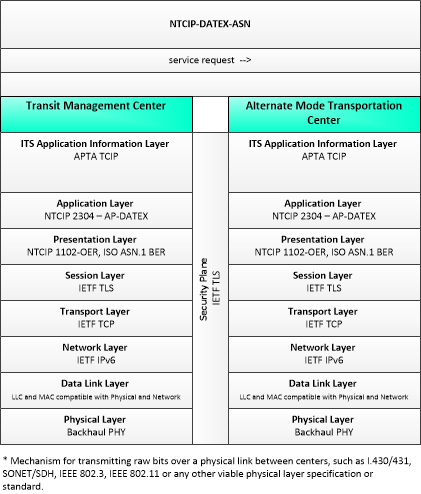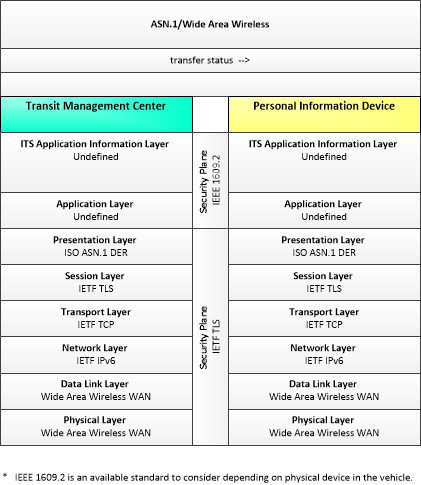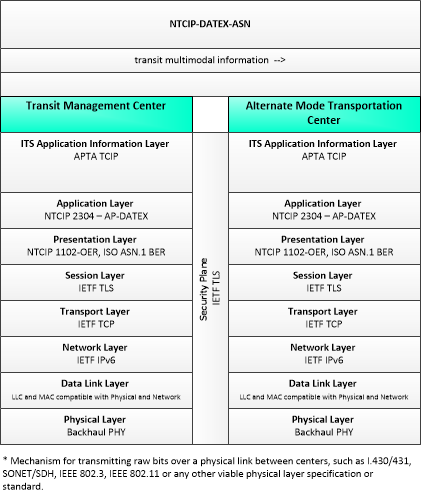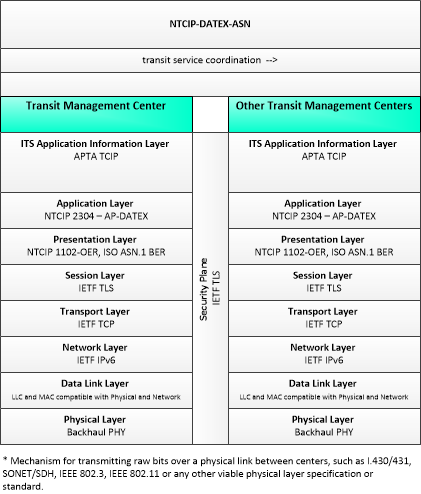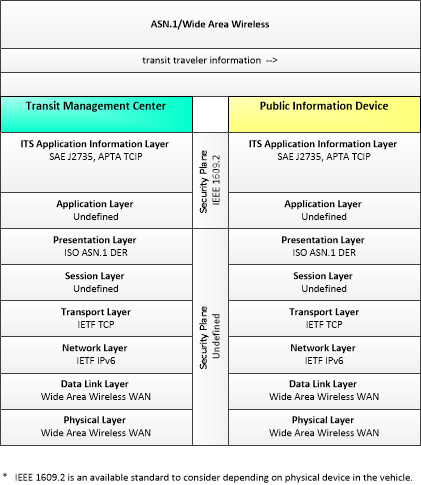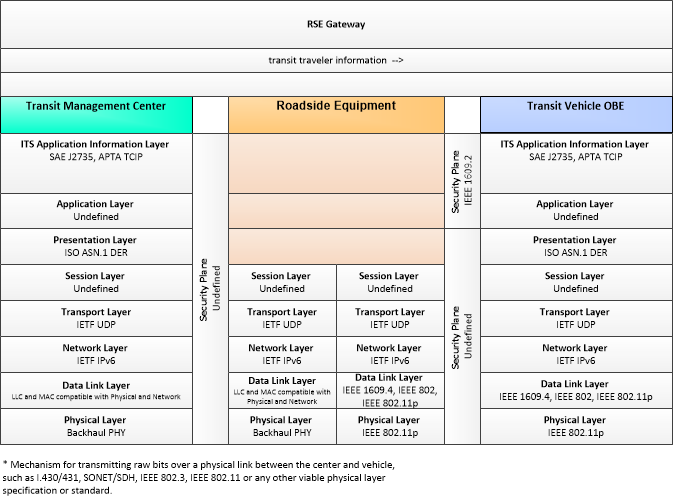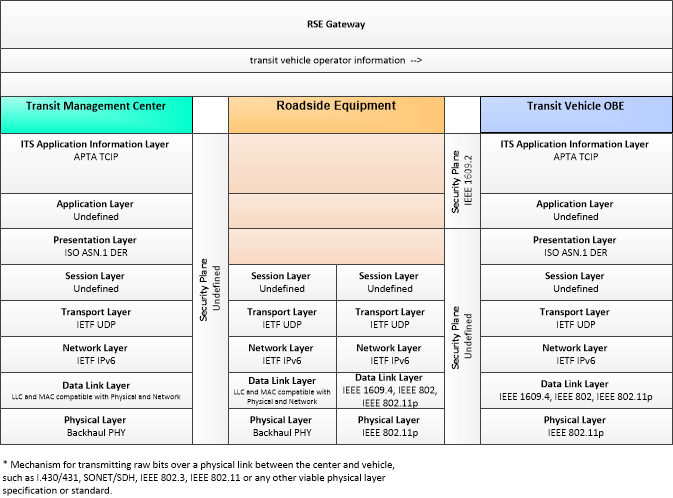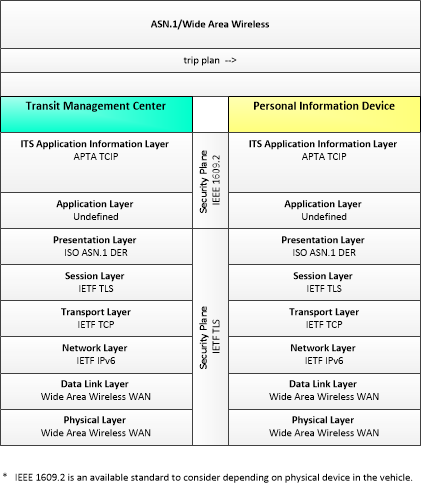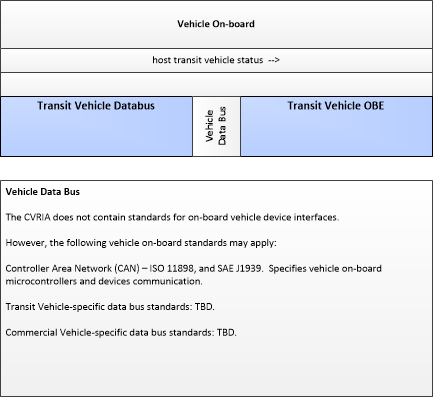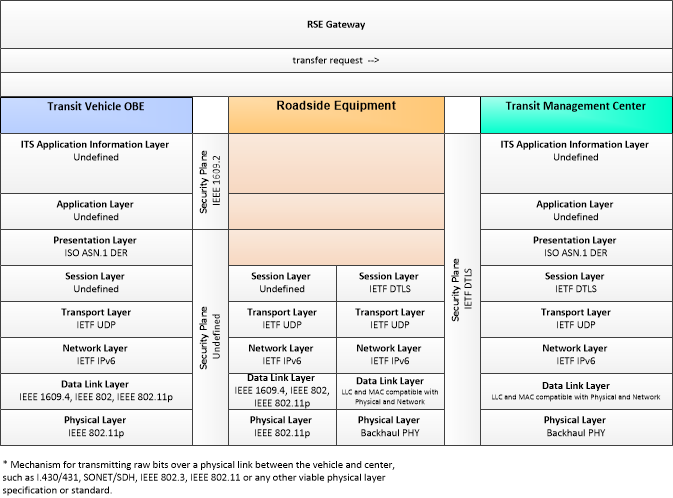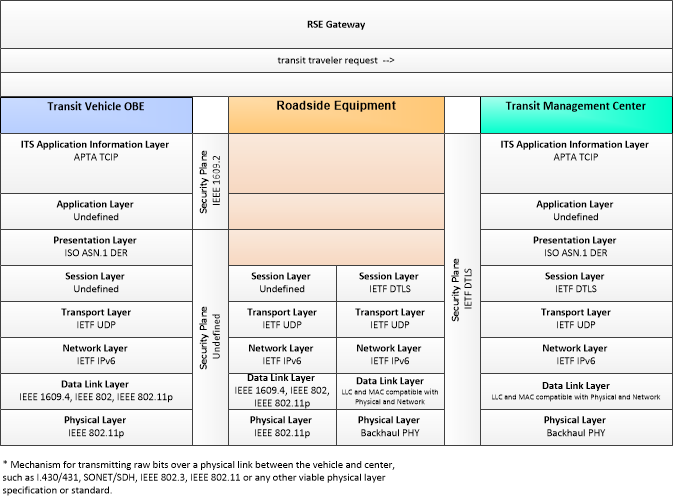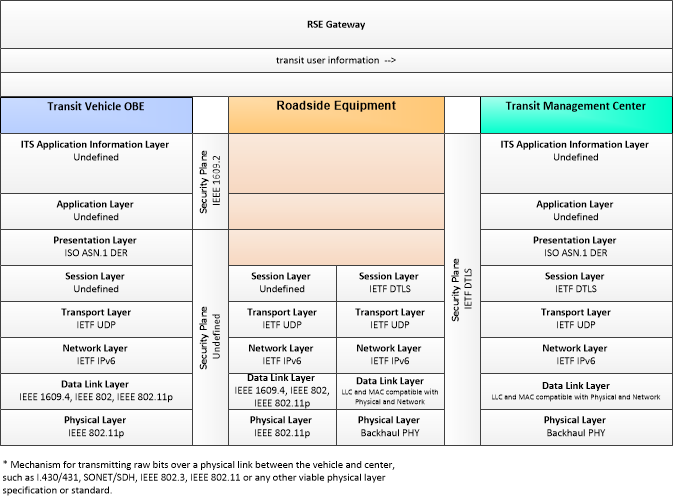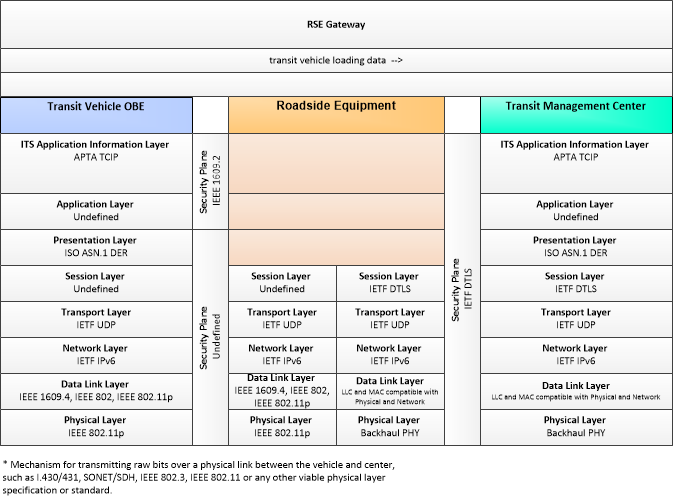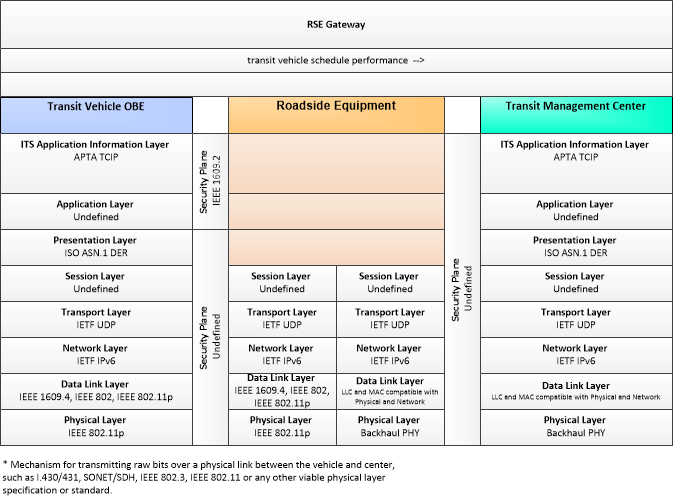Type: Mobility
Groups:- Transit
Transit Connection Protection
The Transit Connection Protection application allows travelers to initiate a request for connection protection anytime during the trip using a personal mobile device, or potentially via transit vehicle or personal automobile onboard equipment / interface, and receive a confirmation indicating whether the request is accepted. Connection protection uses real time data to examine the arrival status of a transit vehicle and to transmit a hold message to a vehicle or other mode of transportation (e.g. rail) in order for the traveler to make a successful transfer from one vehicle to another. Connection protection can be performed within a single agency, across multiple agencies, and across multiple modes. In order to make this application viable a central transfer request brokerage system for processing transfer requests could be created. This tool would be particularly important in an intermodal, multimodal or interagency environment since the existing computer-aided dispatch/ automated vehicle location (CAD/AVL) systems at individual agencies may not have the ability to share or process real-time data available from various external sources (e.g., multi-agency and multimodal operational subsystems) to determine the feasibility of a connection protection request. The system will first determine the feasibility of a transfer based on fixed-schedule and then monitor the real-time status using input from the control center(s).
Enterprise
SVG Diagrams: Installation Operations Maintenance Certification
PNG Diagrams: Installation Operations Maintenance Certification

Business Interaction Matrix:
| Transit Connection Protection Operations Stage | |||||||||||
|---|---|---|---|---|---|---|---|---|---|---|---|
| Other Transit Center Owner | Alternate Mode Transportation Center Owner | Transit Vehicle On-Board Connection Protection Provider | Alternate Mode Transportation Center Operator | Transit Operations Personnel | Transit Vehicle Operator | Traffic Manager | Transit Vehicle Passenger Counting Provider | Traveler | Transit Fleet Manager | Kiosk Provider | |
| Other Transit Center Owner | Information Exchange and Action Agreement | ||||||||||
| Alternate Mode Transportation Center Owner | Employment Agreement | Information Exchange and Action Agreement | |||||||||
| Transit Vehicle On-Board Connection Protection Provider | Application Usage Agreement | ||||||||||
| Alternate Mode Transportation Center Operator | Employment Agreement | ||||||||||
| Transit Operations Personnel | Employment Agreement | ||||||||||
| Transit Vehicle Operator | Vehicle Operating Agreement | ||||||||||
| Traffic Manager | Information Provision Agreement | ||||||||||
| Transit Vehicle Passenger Counting Provider | Application Usage Agreement | ||||||||||
| Traveler | Expectation of Information Provision | ||||||||||
| Transit Fleet Manager | Information Exchange and Action Agreement | Information Exchange and Action Agreement | Application Usage Agreement | Employment Agreement | Vehicle Operating Agreement | Information Provision Agreement | Application Usage Agreement | Expectation of Information Provision | Information Provision Agreement | ||
| Kiosk Provider | Information Provision Agreement | ||||||||||
Includes Enterprise Objects:
| Enterprise Object | Description |
|---|---|
| Alternate Mode Transportation Center Operator | The organization that manages and operates the Alternate Mode Transportation Center. |
| Alternate Mode Transportation Center Owner | The entity that owns and is responsible for operating non-roadway-based transportation systems (e.g. airlines, ferry services, passenger-carrying heavy rail). |
| Application Certification Entity | The body that determines whether an application may be deployed and operated in the Connected Vehicle Environment. This entity's composition, the requirements it applies and the procedures it uses to verify those requirements may vary with application type. For example, applications with human safety component (crash avoidance, movement assistance etc.) may have stringent requirements and extensive testing in a variety of conditions, while applications that provide strictly mobility functionality may have far less testing requirements; possibly as little as just making sure the application doesn't interfere with any other applications. |
| Device Certification Entity | The body that determines whether a device may be deployed and operated in the Connected Vehicle Environment. This entity's composition, the requirements it applies and the procedures it uses to verify those requirements may vary with device type. |
| Federal Regulatory | Federal regulatory bodies that have legal authority to control and/or provide input to policies regulating transportation infrastructure and operations. This includes entities such as the Federal Communications Commission and US Department of Transportation. |
| ITS Certification Entity | The body that determines whether an ITS device or application may be deployed and operated in the transportation environment. This entity's composition, the requirements it applies and the procedures it uses to verify those requirements may vary with device and application type. Typically not a formal body, assigned on a project-by-project basis depending on the type of infrastructure involved. Since ITS projects are locally-focused (typically state or smaller), the entities that are part of this body are typically those with operational jurisdiction where the ITS is installed (e.g., state or local DOTs, state or local maintenance managers etc.) |
| Kiosk Provider | The entity that deploys and operates public information devices. |
| Other Transit Center Owner | The owner of another transit system. This object provides source and destination for flows and relationships between transit system owners. |
| Personal Trip Planning and Route Guidance Installer | Application Component Installers are specified more by role than by function. Installers are responsible for the installation of the application component, which may require a support system, and may entail agreements and relationships between end users and application providers. |
| Personal Trip Planning and Route Guidance Maintainer | Application Component Maintainers are specified more by role than by function. Maintainers are responsible for the maintenance (configuration changes, patches and updates, hardware repairs) of the application component, which may require a support system, and may entail agreements and relationships between end users and application providers. |
| Personal Trip Planning and Route Guidance Provider | Application Component Providers are specified more by role than by function. Providers are responsible for the development of the application component, including initial creation, enhancement and bug fixes. Delivery of the application to the end user may require relationships with other entities (installers, maintainers) if the provider chooses not to fulfill those roles. |
| PID Provider | The entity that designs, manufacturers and provides (either to the end user or to a reseller) the personal information device, including its hardware and base operating software. |
| State Regulatory | State regulatory bodies that have legal authority to control and/or provide input to policies regulating vehicles, transportation infrastructure and operations. This includes entities like Departments of Motor Vehicles, property tax authorities and tolling agencies. |
| Traffic Manager | The entity responsible for the management of traffic, both freeway and arterial. |
| Transit Center Connection Protection Installer | Application Component Installers are specified more by role than by function. Installers are responsible for the installation of the application component, which may require a support system, and may entail agreements and relationships between end users and application providers. |
| Transit Center Connection Protection Maintainer | Application Component Maintainers are specified more by role than by function. Maintainers are responsible for the maintenance (configuration changes, patches and updates, hardware repairs) of the application component, which may require a support system, and may entail agreements and relationships between end users and application providers. |
| Transit Center Connection Protection Provider | Application Component Providers are specified more by role than by function. Providers are responsible for the development of the application component, including initial creation, enhancement and bug fixes. Delivery of the application to the end user may require relationships with other entities (installers, maintainers) if the provider chooses not to fulfill those roles. |
| Transit Center Multi-Modal Coordination Installer | Application Component Installers are specified more by role than by function. Installers are responsible for the installation of the application component, which may require a support system, and may entail agreements and relationships between end users and application providers. |
| Transit Center Multi-Modal Coordination Maintainer | Application Component Maintainers are specified more by role than by function. Maintainers are responsible for the maintenance (configuration changes, patches and updates, hardware repairs) of the application component, which may require a support system, and may entail agreements and relationships between end users and application providers. |
| Transit Center Multi-Modal Coordination Provider | Application Component Providers are specified more by role than by function. Providers are responsible for the development of the application component, including initial creation, enhancement and bug fixes. Delivery of the application to the end user may require relationships with other entities (installers, maintainers) if the provider chooses not to fulfill those roles. |
| Transit Center Passenger Counting Installer | Application Component Installers are specified more by role than by function. Installers are responsible for the installation of the application component, which may require a support system, and may entail agreements and relationships between end users and application providers. |
| Transit Center Passenger Counting Maintainer | Application Component Maintainers are specified more by role than by function. Maintainers are responsible for the maintenance (configuration changes, patches and updates, hardware repairs) of the application component, which may require a support system, and may entail agreements and relationships between end users and application providers. |
| Transit Center Passenger Counting Provider | Application Component Providers are specified more by role than by function. Providers are responsible for the development of the application component, including initial creation, enhancement and bug fixes. Delivery of the application to the end user may require relationships with other entities (installers, maintainers) if the provider chooses not to fulfill those roles. |
| Transit Fleet Manager | The agency or organization that operates transit vehicles. This includes administration, routing, driver instruction, maintenance and any other responsibilities associated with the operations and maintenance of a transit system. |
| Transit Operations Personnel | 'Transit Operations Personnel' represents the people that are responsible for fleet management, maintenance operations, and scheduling activities of the transit system. These different roles represent a variety of individuals in the transit industry. Within the transit industry the person responsible for fleet management is known by many names: Street Supervisor, Starter, Dispatcher, Supervisor, Traffic Controller, Transportation Coordinator. This person actively monitors, controls, and modifies the transit fleet routes and schedules on a day to day basis (dynamic scheduling). The modifications will take account of abnormal situations such as vehicle breakdown, vehicle delay, detours around work zones or incidents (detour management, connection protection, and service restoration), and other causes of route or schedule deviations. Transit operations personnel are also responsible for demand responsive transit operation and for managing emergency situations within the transit network such as silent alarms on board transit vehicles, or the remote disabling of the vehicle. In addition the Transit Operations Personnel may be responsible for assigning vehicle operators to routes, checking vehicle operators in and out, and managing transit stop issues. This object also represents the personnel in the transit garage that are responsible for maintenance of the transit fleets, including monitoring vehicle status, matching vehicles with operators, and maintenance checking of transit vehicles. Finally, it represents the people responsible for planning, development, and management of transit routes and schedules. |
| Transit Stop Information Services Provider | Application Component Providers are specified more by role than by function. Providers are responsible for the development of the application component, including initial creation, enhancement and bug fixes. Delivery of the application to the end user may require relationships with other entities (installers, maintainers) if the provider chooses not to fulfill those roles. |
| Transit Vehicle Manufacturer | The entity which builds transit vehicles. This entity is complementary to the Vehicle Manufacturer entity in that it represents those aspects of vehicle manufacture which are unique to transit vehicles. |
| Transit Vehicle OBE Manufacturer | The Transit Vehicle OBE Manufacturer is the provider of the transit vehicle on-board equipment. This entity may design and build the OBE, or may integrate other components to form the OBE, or may use some combination of approaches to provide the on-board equipment. Since the OBE could be aftermarket, retrofit, built-in or nomadic, this entity is the one that builds whatever that-is. In some cases it may be a smart phone manufacturer, or in others a top tier parts supplier, or any other entity in the production chain, depending on the device and commercial vehicle in question. |
| Transit Vehicle On-Board Connection Protection Installer | The entity responsible for installing the connection protection application resident on board transit vehicles. |
| Transit Vehicle On-Board Connection Protection Maintainer | Application Component Maintainers are specified more by role than by function. Maintainers are responsible for the maintenance (configuration changes, patches and updates, hardware repairs) of the application component, which may require a support system, and may entail agreements and relationships between end users and application providers. |
| Transit Vehicle On-Board Connection Protection Provider | Application Component Providers are specified more by role than by function. Providers are responsible for the development of the application component, including initial creation, enhancement and bug fixes. Delivery of the application to the end user may require relationships with other entities (installers, maintainers) if the provider chooses not to fulfill those roles. |
| Transit Vehicle Operator | The 'Transit Vehicle Operator' represents the person that receives and provides additional information that is specific to operating the ITS functions in all types of transit vehicles. The information received by the operator would include status of on-board systems. Additional information received depends upon the type of transit vehicle. In the case of fixed route transit vehicles, the Transit Vehicle Operator would receive operator instructions that might include actions to take to correct schedule deviations. In the case of flexible fixed routes and demand response routes the information would also include dynamic routing or passenger pickup information. |
| Transit Vehicle Passenger Counting Installer | Application Component Installers are specified more by role than by function. Installers are responsible for the installation of the application component, which may require a support system, and may entail agreements and relationships between end users and application providers. |
| Transit Vehicle Passenger Counting Maintainer | Application Component Maintainers are specified more by role than by function. Maintainers are responsible for the maintenance (configuration changes, patches and updates, hardware repairs) of the application component, which may require a support system, and may entail agreements and relationships between end users and application providers. |
| Transit Vehicle Passenger Counting Provider | Application Component Providers are specified more by role than by function. Providers are responsible for the development of the application component, including initial creation, enhancement and bug fixes. Delivery of the application to the end user may require relationships with other entities (installers, maintainers) if the provider chooses not to fulfill those roles. |
| Traveler | The 'Traveler' represents any individual who uses transportation services. The interfaces to the traveler provide general pre-trip and en-route information supporting trip planning, personal guidance, and requests for assistance in an emergency that are relevant to all transportation system users. It also represents users of a public transportation system and addresses interfaces these users have within a transit vehicle or at transit facilities such as roadside stops and transit centers. |
Includes Resources:
| Resource | Description |
|---|---|
| Alternate Mode Transportation Center | The 'Alternate Mode Transportation Center' provides the interface through which non-ITS transportation systems (e.g., airlines, ferry services, passenger-carrying heavy rail) can exchange data with ITS.. This two-way interface enables coordination for efficient movement of people across multiple transportation modes. It also enables the traveler to efficiently plan itineraries which include segments using other modes. |
| Application Component Certification Requirements | The requirements that define the functionality, performance and operational environment of an application component. Certification Requirements must be met in order for an application to be installed in the CVE. |
| Backoffice Service Development System | The systems used to develop backoffice (center) hardware and software components of applications. |
| Backoffice Service Installation System | The systems used to install and configure backoffice (center) hardware and software components. |
| Backoffice Service Maintenance System | The systems used to maintain and upgrade backoffice (center) hardware and software components. |
| Device Certification Requirements | The requirements that define the functionality, performance and operational environment of a connected vehicle device. Certification Requirements must be met in order for the device to be granted the credentials necessary to operate in the Connected Vehicle Environment. |
| ITS Certification Requirements | The requirements that define the functionality, performance and operational environment of an ITS device or ITS application. Applicability varies with jurisdictions, but typically devices and applications must meet pre-defined acceptance criteria prior to usage in the transportation environment. |
| Mobile Component Development System | The system used in a backoffice environment to develop and test the mobile component of the application. |
| Mobile Component Installation System | The system that interacts with the Vehicle OBE other mobile device and installs the mobile component of the application. |
| Mobile Component Maintenance System | The system used to configure changes and updates to the mobile component of the application. This system is capable of acquiring and reporting diagnostic information about the application's configuration and performance. |
| Other Transit Management Centers | Representing another transit operations center, 'Other Transit Management Centers' is intended to provide a source and destination for information flows between peer transit management centers. It enables transit management activities to be coordinated across geographic boundaries or jurisdictions. |
| Personal Information Device | The 'Personal Information Device' provides the capability for travelers to receive formatted traveler information wherever they are. Capabilities include traveler information, trip planning, and route guidance. Frequently a smart phone, the Personal Information Device provides travelers with the capability to receive route planning and other personally focused transportation services from the infrastructure in the field, at home, at work, or while en-route. Personal Information Devices may operate independently or may be linked with connected vehicle on-board equipment. |
| Personal Trip Planning and Route Guidance | "Personal Trip Planning and Route Guidance" provides a personalized trip plan to the traveler. The trip plan is calculated based on preferences and constraints supplied by the traveler and provided to the traveler for confirmation. Coordination may continue during the trip so that the route plan can be modified to account for new information. Many equipment configurations are possible including systems that provide a basic trip plan to the traveler as well as more sophisticated systems that can provide transition by transition guidance to the traveler along a multi-modal route with transfers. Devices represented by this application object include desktop computers at home, work, or at major trip generation sites, plus personal devices such as tablets and smart phones. |
| PID Component Development System | The system used in a backoffice environment to develop and test the PID component of the application. |
| PID Component Installation System | The system used to install the PID component of a connected vehicle application. |
| PID Component Maintenance System | The system used to configure changes and updates to the PID component of the application. This system is capable of acquiring and reporting diagnostic information about the application's configuration and performance. |
| Public Information Device | The Public Information Device provides access to traveler information at transit stations, transit stops, other fixed sites along travel routes (e.g., rest stops, merchant locations), and major trip generation locations such as special event centers, hotels, office complexes, amusement parks, and theaters. Traveler information access points include kiosks and informational displays supporting varied levels of interaction and information access. At transit stops this might be simple displays providing schedule information and imminent arrival signals. This may be extended to include multi-modal information including traffic conditions and transit schedules to support mode and route selection at major trip generation sites. Personalized route planning and route guidance information can also be provided based on criteria supplied by the traveler. It also supports service enrollment and electronic payment of transit fares. In addition to the traveler information provision, the Public Information Device also supports security and safety monitoring of public areas. This monitoring includes traveler activated silent alarms, as well as surveillance and sensor equipment. The surveillance equipment includes video (e.g. CCTV cameras) and/or audio systems. The sensor equipment includes threat sensors (e.g. chemical agent, toxic industrial chemical, biological, explosives, and radiological sensors) and object detection sensors (e.g. metal detectors). |
| Traffic Management Center | The 'Traffic Management Center' monitors and controls traffic and the road network. It represents centers that manage a broad range of transportation facilities including freeway systems, rural and suburban highway systems, and urban and suburban traffic control systems. It communicates with ITS Roadway Equipment and Connected Vehicle Roadside Equipment (RSE) to monitor and manage traffic flow and monitor the condition of the roadway, surrounding environmental conditions, and field equipment status. It manages traffic and transportation resources to support allied agencies in responding to, and recovering from, incidents ranging from minor traffic incidents through major disasters. |
| Transit Center Connection Protection | "Transit Center Connection Protection" manages the coordination of transit transfers between routes within a single transit agency, between routes of different transit agencies, or between different modes (e.g. a bus transit route and a ferry route). This application object also supports the capability for an individual traveler to obtain connection protection throughout a specific transit trip. This application may be implemented through peer-to-peer sharing between agencies control systems or as a central transit transfer request brokerage that facilitates the management and coordination of transfers across multiple agencies and control systems. |
| Transit Center Multi-Modal Coordination | "Transit Center Multi-Modal Coordination" supports transit service coordination between transit properties and coordinates with other surface and air transportation modes. As part of service coordination, it shares schedule and trip information, as well as transit transfer cluster (a collection of stop points, stations, or terminals where transfers can be made conveniently) and transfer point information between Multimodal Transportation Service Providers, Transit Agencies, and ISPs. An interface to Traffic Management also supports demand management strategies. |
| Transit Center Passenger Counting | "Transit Center Passenger Counting" receives and processes transit vehicle loading data using two-way communications from equipped transit vehicles. |
| Transit Management Center | The 'Transit Management Center' manages transit vehicle fleets and coordinates with other modes and transportation services. It provides operations, maintenance, customer information, planning and management functions for the transit property. It spans distinct central dispatch and garage management systems and supports the spectrum of fixed route, flexible route, paratransit services, transit rail, and bus rapid transit (BRT) service. The physical object's interfaces allow for communication between transit departments and with other operating entities such as emergency response services and traffic management systems. |
| Transit Stop Information Services | "Transit Stop Information Services" furnishes transit users with real-time travel-related information at transit stops, multi-modal transfer points, and other public transportation areas. It provides transit users with information on transit routes, schedules, transfer options, available services, fares, and real-time schedule adherence. In addition to tailored information for individual transit users, it supports general annunciation and/or display of imminent arrival information and other information of general interest to transit users. |
| Transit Vehicle | The vehicle that provides the sensory, processing, storage, and communications functions necessary to support safe and efficient movement of passengers. This includes buses, paratransit vehicles, light rail vehicles, other vehicles designed to carry passengers, and supervisory vehicles. |
| Transit Vehicle Databus | The 'Transit Vehicle Databus' represents the vehicle databus that interfaces with on-board equipment on a transit vehicle. It is a specialized and extended form of the Vehicle Databus that is subject to different vehicle databus standards and hosts a broad range of components that are unique to a transit vehicle including the farebox and associated electronics, passenger counters, and transit security systems. As a specialized form of the Vehicle Databus, it also provides access to the general-purpose sensors (e.g., radars, cameras), GPS, drive train monitoring and control systems, and vehicle safety features that support connected vehicle applications. The Transit Vehicle may represent a bus, paratransit vehicle, light rail vehicle, or other vehicle designed to carry passengers. In CVRIA, the 'Transit Vehicle Databus' is used to represent the onboard interactions between the Transit Vehicle OBE and the other systems included in a host transit vehicle. |
| Transit Vehicle OBE | The Transit Vehicle On-Board equipment (OBE) resides in a transit vehicle and provides the sensory, processing, storage, and communications functions necessary to support safe and efficient movement of passengers. The types of transit vehicles containing this physical object include buses, paratransit vehicles, light rail vehicles, other vehicles designed to carry passengers, and supervisory vehicles. It collects ridership levels and supports electronic fare collection. It supports a traffic signal prioritization function that communicates with the roadside physical object to improve on-schedule performance. Automated vehicle location enhances the information available to the transit operator enabling more efficient operations. On-board sensors support transit vehicle maintenance. The physical object supports on-board security and safety monitoring. This monitoring includes transit user or vehicle operator activated alarms (silent or audible), as well as surveillance and sensor equipment. The surveillance equipment includes video (e.g. CCTV cameras), audio systems and/or event recorder systems. It also furnishes travelers with real-time travel information, continuously updated schedules, transfer options, routes, and fares. In CVRIA, a separate 'Vehicle OBE' physical object supports the general V2V and V2I safety applications and other applications that apply to all vehicles, including transit vehicles. The Transit Vehicle OBE supplements these general capabilities with capabilities that are specific to transit vehicles. |
| Transit Vehicle On-Board Connection Protection | "Transit Vehicle On-Board Connection Protection" monitors vehicle schedule performance and provides it to the transit center for connection protection processing. It receives operator instructions relating to managing connection protection and recognizes individual travelers who have arranged for connection protection and provides connection protection information to the transit center. |
| Transit Vehicle Passenger Counting | "Transit Vehicle Passenger Counting" collects transit vehicle loading data and makes it available to the center. |
Includes Roles:
| Role | Description |
|---|---|
| Certifies | An Enterprise verifies that a target Resource meets relevant performance, functional, environmental and quality requirements. |
| Constrains | A Resource or Enterprise applies requirements, constraints and associated tests to another Resource. |
| Develops | An Enterprise creates the target Resource or Document. |
| Installs | An Enterprise performs the initial delivery, integration and configuration of the target Resource. |
| Maintains | An Enterprise administers the hardware and software that comprise the target Resource. |
| Member | An Enterprise is part of another larger, target Enterprise. |
| Operates | An Enterprise controls the functionality and state of the target Resource. An Enterprise that Operates a resource is considered Responsible. |
| Owns | An Enterprise has financial ownership and control over the Resource. An Enterprise that Owns a resource is considered Accountable. |
Includes Coordination:
| Coordination | Type | Description |
|---|---|---|
| Application Installation Agreement | Agreement | An agreement that grants one party permission to install an application component on a device controlled by the other party. |
| Application Installation Data | Information Sharing | Data needed to install the application, including the application executable code and any configuration data. Unidirectional flow. |
| Application Interface Specification | Agreement | The definition of an interface between two application components that operate on two distinct pieces of hardware. The Application Interface Specification is specific to the application in question. |
| Application Maintenance Data | Information Sharing | Data used to facilitate the upgrade, patching and general health maintenance of an application component. |
| Application Performance Data | Information Sharing | Data used to characterize application performance, including such measures as availability, known errors and known uses. |
| Application Procurement Agreement | Agreement | An agreement whereupon one entity provides a copy of an application component to another entity. This component is capable of being installed and functioning, according to its requirements that passed through the application's certification process. |
| Application Usage Agreement | Agreement | An agreement in which one entity that controls an application component's use gives the other entity the necessary tools and permission to operate that application or application component. |
| Backoffice Component Installation Agreement | Agreement | An agreement that grants one party permission to install a backoffice application component on a center-based device controlled by the other party. |
| Backoffice Component Maintenance Agreement | Agreement | An agreement in which one entity maintains the operational status of the backoffice component of an application under the control of another entity. This maintenance may include routine and as-needed maintenance, such as software update and configuration, hardware replacement and related system administration activities. |
| Employment Agreement | Agreement | An agreement between an individual and a corporation or government entity, whereupon the individual agrees to provide labor to the corporation/agency, which in turn compensates the employee. Stipulates level of compensation, working conditions, necessary equipment and training and expectations of employee performance. |
| Expectation of Action | Expectation | An expectation where one party expects another party to take a specific action, typically in response to data or information provided by the first party, but without any formal agreement. |
| Expectation of Information Provision | Expectation | An expectation where one party believes another party will provide it information whenever such information is likely relevant to the recipient. |
| Includes | Includes | Indicates that one component is entirely contained within another component. |
| Information Exchange and Action Agreement | Agreement | An agreement to exchange information, which may include data or control information; the exact information to be exchanged may vary from agreement to agreement. This also includes a specification for action that shall, should or may be taken by one party in response to this information. |
| Information Provision Agreement | Agreement | An agreement where one party agrees to provide information to another party. This is a unidirectional agreement. |
| Interface Description | Agreement | Documentation of the interface between two systems, where one system does not have an application component that is part of the application, but does provide and/or receive data and/or information that is used by or sourced from the application. In many cases this is an existing interface used by the application, so the description of the interface already exists and is imposed by the terminator. |
| Maintenance Data Exchange Agreement | Agreement | An agreement that states one entity will provide data related to maintenance of an application component to the other entity. |
| Mobile Component Installation Agreement | Agreement | An agreement whereupon the controller of OBE gives another party permission to install, configure and make operational a component that enables the mobile portion of an application. |
| Mobile Component License Agreement | Agreement | An end-user license agreement allowing the operator of the mobile device to use the mobile application component that is part of the application in question. |
| Mobile Component Maintenance Agreement | Agreement | An agreement in which one entity maintains the operational status of the mobile component of an application under the control of another entity. This maintenance may include routine and as-needed maintenance, such as software update and configuration, hardware replacement and related system administration activities. |
| Vehicle Data Access Agreement | Agreement | An agreement whereby the party that controls access to on-board vehicle data grants another party the right and ability to access that data. Includes the conditions under which data may be accessed, and specifies the mechanisms, including physical and functional access methods, data formats and any other considerations necessary for the accessing party to acquire data. May also include caveats regarding responsibility for data quality and responsibility for use of the data. |
| Vehicle Operating Agreement | Agreement | An agreement whereupon the controller of a vehicle grants another entity permission and rights to operate the vehicle. |
| Vehicle Procurement Agreement | Agreement | The exchange of a vehicle for compensation. One entity purchases the vehicle from the other. |
| Warranty | Agreement | A guarantee or promise made by one entity to another, that provides assurance of the functionality and performance over time of an application component. |
Functional
Includes Processes:
Includes Data Flows:
Physical
SVG Diagram
PNG Diagram

Includes Physical Objects:
| Physical Object | Class | Description |
|---|---|---|
| Alternate Mode Transportation Center | Center | The 'Alternate Mode Transportation Center' provides the interface through which non-ITS transportation systems (e.g., airlines, ferry services, passenger-carrying heavy rail) can exchange data with ITS.. This two-way interface enables coordination for efficient movement of people across multiple transportation modes. It also enables the traveler to efficiently plan itineraries which include segments using other modes. |
| Other Transit Management Centers | Center | Representing another transit operations center, 'Other Transit Management Centers' is intended to provide a source and destination for information flows between peer transit management centers. It enables transit management activities to be coordinated across geographic boundaries or jurisdictions. |
| Personal Information Device | Traveler | The 'Personal Information Device' provides the capability for travelers to receive formatted traveler information wherever they are. Capabilities include traveler information, trip planning, and route guidance. Frequently a smart phone, the Personal Information Device provides travelers with the capability to receive route planning and other personally focused transportation services from the infrastructure in the field, at home, at work, or while en-route. Personal Information Devices may operate independently or may be linked with connected vehicle on-board equipment. |
| Public Information Device | Traveler | The Public Information Device provides access to traveler information at transit stations, transit stops, other fixed sites along travel routes (e.g., rest stops, merchant locations), and major trip generation locations such as special event centers, hotels, office complexes, amusement parks, and theaters. Traveler information access points include kiosks and informational displays supporting varied levels of interaction and information access. At transit stops this might be simple displays providing schedule information and imminent arrival signals. This may be extended to include multi-modal information including traffic conditions and transit schedules to support mode and route selection at major trip generation sites. Personalized route planning and route guidance information can also be provided based on criteria supplied by the traveler. It also supports service enrollment and electronic payment of transit fares. In addition to the traveler information provision, the Public Information Device also supports security and safety monitoring of public areas. This monitoring includes traveler activated silent alarms, as well as surveillance and sensor equipment. The surveillance equipment includes video (e.g. CCTV cameras) and/or audio systems. The sensor equipment includes threat sensors (e.g. chemical agent, toxic industrial chemical, biological, explosives, and radiological sensors) and object detection sensors (e.g. metal detectors). |
| Traffic Management Center | Center | The 'Traffic Management Center' monitors and controls traffic and the road network. It represents centers that manage a broad range of transportation facilities including freeway systems, rural and suburban highway systems, and urban and suburban traffic control systems. It communicates with ITS Roadway Equipment and Connected Vehicle Roadside Equipment (RSE) to monitor and manage traffic flow and monitor the condition of the roadway, surrounding environmental conditions, and field equipment status. It manages traffic and transportation resources to support allied agencies in responding to, and recovering from, incidents ranging from minor traffic incidents through major disasters. |
| Transit Management Center | Center | The 'Transit Management Center' manages transit vehicle fleets and coordinates with other modes and transportation services. It provides operations, maintenance, customer information, planning and management functions for the transit property. It spans distinct central dispatch and garage management systems and supports the spectrum of fixed route, flexible route, paratransit services, transit rail, and bus rapid transit (BRT) service. The physical object's interfaces allow for communication between transit departments and with other operating entities such as emergency response services and traffic management systems. |
| Transit Operations Personnel | Center | 'Transit Operations Personnel' represents the people that are responsible for fleet management, maintenance operations, and scheduling activities of the transit system. These different roles represent a variety of individuals in the transit industry. Within the transit industry the person responsible for fleet management is known by many names: Street Supervisor, Starter, Dispatcher, Supervisor, Traffic Controller, Transportation Coordinator. This person actively monitors, controls, and modifies the transit fleet routes and schedules on a day to day basis (dynamic scheduling). The modifications will take account of abnormal situations such as vehicle breakdown, vehicle delay, detours around work zones or incidents (detour management, connection protection, and service restoration), and other causes of route or schedule deviations. Transit operations personnel are also responsible for demand responsive transit operation and for managing emergency situations within the transit network such as silent alarms on board transit vehicles, or the remote disabling of the vehicle. In addition the Transit Operations Personnel may be responsible for assigning vehicle operators to routes, checking vehicle operators in and out, and managing transit stop issues. This object also represents the personnel in the transit garage that are responsible for maintenance of the transit fleets, including monitoring vehicle status, matching vehicles with operators, and maintenance checking of transit vehicles. Finally, it represents the people responsible for planning, development, and management of transit routes and schedules. |
| Transit Vehicle Databus | Vehicle | The 'Transit Vehicle Databus' represents the vehicle databus that interfaces with on-board equipment on a transit vehicle. It is a specialized and extended form of the Vehicle Databus that is subject to different vehicle databus standards and hosts a broad range of components that are unique to a transit vehicle including the farebox and associated electronics, passenger counters, and transit security systems. As a specialized form of the Vehicle Databus, it also provides access to the general-purpose sensors (e.g., radars, cameras), GPS, drive train monitoring and control systems, and vehicle safety features that support connected vehicle applications. The Transit Vehicle may represent a bus, paratransit vehicle, light rail vehicle, or other vehicle designed to carry passengers. In CVRIA, the 'Transit Vehicle Databus' is used to represent the onboard interactions between the Transit Vehicle OBE and the other systems included in a host transit vehicle. |
| Transit Vehicle OBE | Vehicle | The Transit Vehicle On-Board equipment (OBE) resides in a transit vehicle and provides the sensory, processing, storage, and communications functions necessary to support safe and efficient movement of passengers. The types of transit vehicles containing this physical object include buses, paratransit vehicles, light rail vehicles, other vehicles designed to carry passengers, and supervisory vehicles. It collects ridership levels and supports electronic fare collection. It supports a traffic signal prioritization function that communicates with the roadside physical object to improve on-schedule performance. Automated vehicle location enhances the information available to the transit operator enabling more efficient operations. On-board sensors support transit vehicle maintenance. The physical object supports on-board security and safety monitoring. This monitoring includes transit user or vehicle operator activated alarms (silent or audible), as well as surveillance and sensor equipment. The surveillance equipment includes video (e.g. CCTV cameras), audio systems and/or event recorder systems. It also furnishes travelers with real-time travel information, continuously updated schedules, transfer options, routes, and fares. In CVRIA, a separate 'Vehicle OBE' physical object supports the general V2V and V2I safety applications and other applications that apply to all vehicles, including transit vehicles. The Transit Vehicle OBE supplements these general capabilities with capabilities that are specific to transit vehicles. |
| Transit Vehicle Operator | Vehicle | The 'Transit Vehicle Operator' represents the person that receives and provides additional information that is specific to operating the ITS functions in all types of transit vehicles. The information received by the operator would include status of on-board systems. Additional information received depends upon the type of transit vehicle. In the case of fixed route transit vehicles, the Transit Vehicle Operator would receive operator instructions that might include actions to take to correct schedule deviations. In the case of flexible fixed routes and demand response routes the information would also include dynamic routing or passenger pickup information. |
Includes Application Objects:
| Application Object | Description | Physical Object |
|---|---|---|
| Personal Trip Planning and Route Guidance | "Personal Trip Planning and Route Guidance" provides a personalized trip plan to the traveler. The trip plan is calculated based on preferences and constraints supplied by the traveler and provided to the traveler for confirmation. Coordination may continue during the trip so that the route plan can be modified to account for new information. Many equipment configurations are possible including systems that provide a basic trip plan to the traveler as well as more sophisticated systems that can provide transition by transition guidance to the traveler along a multi-modal route with transfers. Devices represented by this application object include desktop computers at home, work, or at major trip generation sites, plus personal devices such as tablets and smart phones. | Personal Information Device |
| Transit Center Connection Protection | "Transit Center Connection Protection" manages the coordination of transit transfers between routes within a single transit agency, between routes of different transit agencies, or between different modes (e.g. a bus transit route and a ferry route). This application object also supports the capability for an individual traveler to obtain connection protection throughout a specific transit trip. This application may be implemented through peer-to-peer sharing between agencies control systems or as a central transit transfer request brokerage that facilitates the management and coordination of transfers across multiple agencies and control systems. | Transit Management Center |
| Transit Center Multi-Modal Coordination | "Transit Center Multi-Modal Coordination" supports transit service coordination between transit properties and coordinates with other surface and air transportation modes. As part of service coordination, it shares schedule and trip information, as well as transit transfer cluster (a collection of stop points, stations, or terminals where transfers can be made conveniently) and transfer point information between Multimodal Transportation Service Providers, Transit Agencies, and ISPs. An interface to Traffic Management also supports demand management strategies. | Transit Management Center |
| Transit Center Passenger Counting | "Transit Center Passenger Counting" receives and processes transit vehicle loading data using two-way communications from equipped transit vehicles. | Transit Management Center |
| Transit Stop Information Services | "Transit Stop Information Services" furnishes transit users with real-time travel-related information at transit stops, multi-modal transfer points, and other public transportation areas. It provides transit users with information on transit routes, schedules, transfer options, available services, fares, and real-time schedule adherence. In addition to tailored information for individual transit users, it supports general annunciation and/or display of imminent arrival information and other information of general interest to transit users. | Public Information Device |
| Transit Vehicle On-Board Connection Protection | "Transit Vehicle On-Board Connection Protection" monitors vehicle schedule performance and provides it to the transit center for connection protection processing. It receives operator instructions relating to managing connection protection and recognizes individual travelers who have arranged for connection protection and provides connection protection information to the transit center. | Transit Vehicle OBE |
| Transit Vehicle Passenger Counting | "Transit Vehicle Passenger Counting" collects transit vehicle loading data and makes it available to the center. | Transit Vehicle OBE |
Includes Information Flows:
| Information Flow | Description |
|---|---|
| connection protection instructions | A request to hold at a specific stop for a specified time period to protect connections. This flow would also include subsequent adjustments to, or cancellation of, a hold request. |
| host transit vehicle status | Information provided to the Connected Vehicle on-board equipment from other systems on the Transit Vehicle Platform. |
| multimodal service data | Multimodal transportation schedules and other service information. |
| road network conditions | Current and forecasted traffic information, road and weather conditions, and other road network status. Either raw data, processed data, or some combination of both may be provided by this flow. Information on diversions and alternate routes, closures, and special traffic restrictions (lane/shoulder use, weight restrictions, width restrictions, HOV requirements) in effect is included. |
| service request | Request to multimodal (possibly non-roadway) transit provider for general services information and specific trip information or reservation. |
| service response | Multimodal (possibly non-roadway) transit provider services information and trip reservation confirmations. |
| transfer request | A traveler request for a transfer between transit routes, services, or modes. The request may also include preferences such as a need for extra connection time or connection protection in the event of a delay. |
| transfer status | Information indicating whether a requested transfer can be confirmed including specific information about the connection including fare payment information. Real-time updates are provided if the transfer status changes up to and including a reminder just prior to the transfer. In the event that a requested transfer is not feasible, alternatives including other transit, rideshare, and taxi options are provided. |
| transit information user request | Request for special transit routing, real-time schedule information, and availability information. |
| transit multimodal information | Transit schedule information for coordination at modal interchange points. |
| transit operations personnel input | User input from transit operations personnel including instructions governing service availability, schedules, emergency response plans, transit personnel assignments, transit maintenance requirements, and other inputs that establish general system operating requirements and procedures. |
| transit operations status | Presentation of information to transit operations personnel including accumulated schedule and fare information, ridership and on-time performance information, emergency response plans, transit personnel information, maintenance records, and other information intended to support overall planning and management of a transit property. |
| transit service coordination | Schedule coordination or AVL information shared between local/regional transit organizations. This includes coordination of connections between transit properties. |
| transit traveler information | Transit information prepared to support transit users and other travelers. It contains transit schedules, real-time arrival information, fare schedules, alerts and advisories, and general transit service information. |
| transit traveler request | Request by a Transit traveler to summon assistance, request transit information, or request any other transit services. |
| transit user information | Information about individual transit users boarding a transit vehicle, used to track a user's progress on a scheduled transit trip. |
| transit vehicle loading data | Data collected on board the transit vehicle relating to passenger boarding and alighting. |
| transit vehicle operator display | Visual, audible, and tactile outputs to the transit vehicle operator including vehicle surveillance information, alarm information, vehicle system status, information from the operations center, and information indicating the status of all other on-board ITS services. |
| transit vehicle operator information | Transit service instructions, wide area alerts, traffic information, road conditions, and other information for both transit and paratransit operators. |
| transit vehicle operator input | Transit vehicle operator inputs to on-board ITS equipment, including tactile and verbal inputs. Includes authentication information, on-board system control, emergency requests, and fare transaction data. |
| transit vehicle schedule performance | Estimated times of arrival and anticipated schedule deviations reported by a transit vehicle. |
| trip confirmation | Acknowledgement by the driver/traveler of acceptance of a trip plan with associated personal and payment information required to confirm reservations. |
| trip plan | A travel itinerary identifying a route and associated traveler information and instructions identifying recommended modes and transfer information, ride sharing options, and transit and parking reservation information. |
Application Interconnect Diagram
SVG Diagram
PNG Diagram
Application Triples
Requirements
| Need | Requirement | ||
|---|---|---|---|
| N2.152 | Transit Connection Protection (T-CONNECT) needs to know the expected arrival time of a transit vehicle at its next stop so that it may make appropriate decisions/suggestions to protect traveler's connections. | 2.329 | Transit Connection Protection (T-CONNECT) shall be able to receive expected arrival time information for transit vehicles from transit vehicles. |
| 2.330 | T-CONNECT shall be able to receive expected arrival time information for transit vehicles from transit management systems. | ||
| 2.331 | T-CONNECT shall maintain a listing of transit vehicles and their expected arrivals at their next stops. | ||
| N2.153 | T-CONNECT needs to know the scheduled arrival time of a transit vehicle at its next stop so that it may make appropriate decisions/suggestions to protect traveler's connections. | 2.332 | T-CONNECT shall be able to receive scheduled arrival time information for transit vehicles from transit management systems. |
| 2.333 | T-CONNECT shall maintain a listing of transit vehicles and their scheduled arrivals at their next stops. | ||
| N2.154 | T-CONNECT needs to send a hold message to another vehicle if the transit vehicle's arrival time differential falls within a threshold, to protect a traveler's connection. | 2.334 | T-CONNECT shall issue hold requests only when the expected arrival time of the late arriving vehicle falls within a threshold. |
| 2.335 | T-CONNECT shall provide a mechanism for the operator of T-CONNECT to specify the late threshold T-CONNECT uses to determine whether to issue wait requests. | ||
| N2.155 | T-CONNECT needs to collect desired destination, origination and departure time from the traveler so that it may determine viable routes and transfer points. | 2.336 | T-CONNECT shall provide a mechanism for travelers to input desired trip information. |
| 2.337 | T-CONNECT shall inform the traveler of the operational scope of T-CONNECT when they attempt to input travel information, including the geographic scope and included travel systems. | ||
| N2.156 | T-CONNECT needs to determine viable routes and transfer points/times given a traveler's O/D, time and travel preferences. | 2.338 | T-CONNECT shall compare a traveler's desired trip to scheduled routes. |
| 2.339 | T-CONNECT shall determine the feasibility of a traveler's desired route, considering the comparison to scheduled routes. | ||
| 2.340 | T-CONNECT shall determine the routes, transfer points and times for feasible routes. | ||
| N2.157 | T-CONNECT needs to provide transfer points to a Traveler using available transit routes and traveler's preferences. | 2.341 | T-CONNECT shall prioritize feasible routes and transfers based on the traveler's preferences. |
| 2.342 | T-CONNECT shall compare the transit services used on a traveler's route to the traveler's travel preferences. | ||
| N2.158 | T-CONNECT needs to collect travel preferences a Traveler provides so that this information can be used when determining routing and transfer points, to reflect the traveler's preferences. | 2.343 | T-CONNECT shall collect travel preference information from travelers. |
| 2.344 | T-CONNECT shall allow travelers to prioritize different transit services. | ||
| N2.159 | T-CONNECT needs to notify travelers of the feasibility of their travel plans. | 2.345 | T-CONNECT shall provide the feasible routes and transfer points/times to the traveler. |
| N2.159a | T-CONNECT needs to notify travelers of the cost of a trip. | 2.345a | T-CONNECT shall provide the traveler with information about the cost of a trip requested by the traveler. |
| N2.160 | T-CONNECT needs to monitor the real-time location of transit vehicles. | 2.346 | T-CONNECT shall acquire transit vehicle location information from Transit Management Centers. |
| 2.347 | T-CONNECT shall record the current location of all transit vehicles for which it receives location information. | ||
| N2.161 | T-CONNECT needs to know the fixed route schedule of all transit vehicles. | 2.348 | T-CONNECT shall acquire fixed route schedule information from Transit MCs. |
| 2.349 | T-CONNECT shall maintain a listing of the fixed route schedules of all transit vehicles in T-CONNECT's operational area. | ||
| N2.162 | T-CONNECT needs to compare the current location of transit vehicles with their fixed route schedule to quantify schedule adherence. | 2.350 | T-CONNECT shall compare the current location of transit vehicles with their scheduled location. |
| N2.163 | T-CONNECT needs to issue wait requests to transit vehicles that may receive a connecting traveler if that traveler is on a late arriving vehicle and the transfer falls within a predetermined threshold for waiting. | 2.351 | T-CONNECT shall maintain a list of travelers that have trips scheduled with T-CONNECT. |
| 2.352 | T-CONNECT shall be able to receive traveler location information. | ||
| 2.353 | For each T-CONNECT protected trip where a traveler is on a transit vehicle that is behind schedule, T-CONNECT shall issue a wait request to the connecting vehicle. | ||
| N2.164 | T-CONNECT needs to notify affected Travelers of wait requests. | 2.354 | For each wait request sent to transit vehicles, T-CONNECT shall determine the travelers that are on or waiting for the transit vehicle that is being asked to wait. |
| 2.355 | For each wait request sent to transit vehicles, T-CONNECT shall forward a copy of the request to the travelers that are on the transit vehicles that are being asked to wait. | ||
| N2.165 | T-CONNECT needs to notify affected Travelers of connection protection. | 2.356 | For each wait request sent to transit vehicles, T-CONNECT shall forward a copy of the request to the travelers that are on the behind-schedule vehicle that triggered the request. |
| N2.166 | T-CONNECT needs to provide rideshare requests to D-RIDE | 2.357 | For traveler routes that include carpool options, T-CONNECT shall forward those requests to D-RIDE. |
| N2.167 | T-CONNECT needs to provide connection protection between transit vehicles operated by different agencies. | 2.358 | T-CONNECT shall issue connection protections meeting all other requirements when transit vehicles involved are operated by the different agencies. |
| 2.359 | T-CONNECT shall issue connection protections meeting all other requirements when transit vehicles involved are operated by the same agency. | ||
| N2.168 | T-CONNECT needs to provide connection protection between transit vehicles using differing modes. | 2.360 | T-CONNECT shall issue connection protections meeting all other requirements when transit vehicles involved are the same mode. |
| 2.361 | T-CONNECT shall issue connection protections meeting all other requirements when transit vehicles involved are dissimilar modes. | ||
Related Sources
- Report on Functional Requirements and Software Architecture for the IDTO Prototype Phase I Demonstration Site (Columbus), Final, 8/30/2013
- ConOps for Transit Connected Vehicle, Draft, 3/31/2012
- Integrated Dynamic Transit Operations (IDTO) ConOps, Draft v3.0, 5/11/2012
- Report on Functional and Performance Requirements and High-Level Data and Communication Needs for Integrated Dynamic Transit Operations (IDTO), Final, 8/13/2012
Security
In order to participate in this application, each physical object should meet or exceed the following security levels.
| Physical Object Security | ||||
|---|---|---|---|---|
| Physical Object | Confidentiality | Integrity | Availability | Security Class |
| Security levels have not been defined yet. | ||||
In order to participate in this application, each information flow triple should meet or exceed the following security levels.
| Information Flow Security | |||||
|---|---|---|---|---|---|
| Source | Destination | Information Flow | Confidentiality | Integrity | Availability |
| Basis | Basis | Basis | |||
| Security levels have not been defined yet. | |||||
